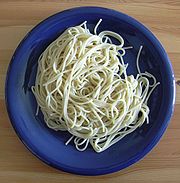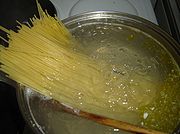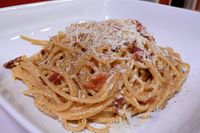Spaghetti

Spaghetti is a long, thin, cylindrical pasta of Italian origin.[1] Spaghetti is made of semolina or flour and water. Italian dried spaghetti is made from durum wheat semolina, but outside of Italy it may be made with other kinds of flour. Traditionally most spaghetti was 50cm (20ins) long, but shorter lengths gained in popularity during the latter half of the 20th century and now spaghetti is most commonly available in 25-30cm (10-12in) lengths. A variety of pasta dishes are based on it, from spaghetti with cheese and pepper or garlic and oil to a spaghetti with tomato, meat, and other sauces.
Contents |
Etymology
Spaghetti is the plural form of the Italian word spaghetto, which is a diminutive of spago, meaning "thin string" or "twine".
Origins
Pasta in the West may first have been worked to long, thin forms in Southern Italy around the 12th Century.[2] The popularity of pasta spread to the whole of Italy after the establishment of pasta factories in the 19th century, enabling the mass production of pasta for the Italian market.[3]
In the United States around the end of the 1800s, spaghetti was offered in restaurants as Spaghetti Italienne (which likely consisted of extremely soggy noodles and a tomato sauce diluted with broth) and it wasn't until decades later that it came to be prepared with garlic or peppers.[4] Canned spaghetti, kits for making spaghetti, and spaghetti with meatballs became popular, and the dish has become a staple in the U.S.[4]
Preparation

Spaghetti is cooked in a large pot of salted, boiling water (about 5 liters for 2 persons) which is brought to boiling. Then one or two spoons of salt are added and after a minute or so the pasta is added. After 10 to 15 minutes (the timing is most often written on the packaging of sundry brands and thicknesses) the spaghetti is drained of water with a colander (scolapasta in Italian).
A widely noted, finished consistency of pasta is called al dente (Italian for to the tooth), soft but with texture, sometimes even with bite in the center. However, spaghetti is sometimes cooked to a much softer consistency. Spaghettoni is a thicker spaghetti which takes more time to cook. Spaghettini and vermicelli are very thin spaghettis (both of which may be called angel hair spaghetti in English) which take less time to cook.
Serving

An emblem of Italian cuisine, spaghetti is frequently served with tomato sauce, which may contain various herbs (especially oregano, and basil), olive oil, meat, or vegetables. Other spaghetti preparations include using Bolognese sauce, alfredo and carbonara. Grated hard cheeses, such as Pecorino Romano, Parmesan, and Asiago cheese, are often added.
Records
The world record for largest bowl of spaghetti was set in March 2009 and reset in March 2010 when a restaurant in Garden Grove, Buca di Beppo, outside of Los Angeles successfully filled a swimming pool with more than 13,780 pounds (6,251 kg) of pasta.[5]
See also
- Carbonara
- Lai fun
- Soba
- Spaghetti squash
- Capellini
- List of pasta
- Fideo
- Spaghettieis: an ice cream dessert which looks like spaghetti with tomato sauce.
References
- ↑ spaghetti. Dictionary.com. Dictionary.com Unabridged (v 1.1). Random House, Inc. http://dictionary.reference.com/browse/spaghetti (accessed: June 03, 2008).
- ↑ http://www.theatlantic.com/doc/198607/pasta
- ↑ Kate Whiteman, Jeni Wright and Angela Boggiano, The Italian Kitchen Bible, Hermes House, p.12-13
- ↑ 4.0 4.1 Levenstein, Harvey; in Carole M. Counihan (ed.) (2002). Food in the USA: A Reader. Routledge. pp. 77–89. ISBN 0-415-93232-7.
- ↑ KTLA News (March 12, 2010). "Restaurant Sets World Record with Pool of Spaghetti". KTLA. http://www.ktla.com/news/landing/ktla-biggest-pasta-bowl,0,5522564.story.
|
||||||||